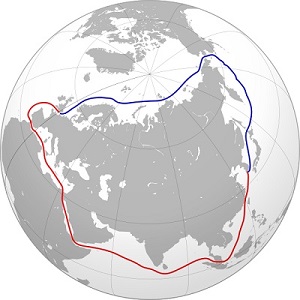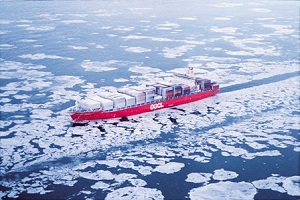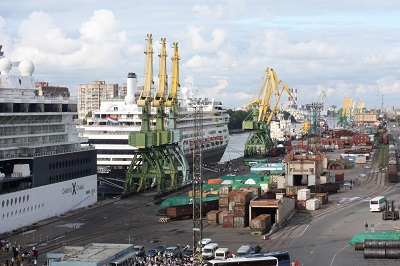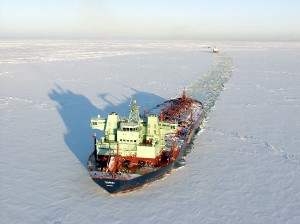Opportunities and Challenges in the Russian North
Op-Ed by Simon Williams and Philipp Hermes
“High north, low tension”– reiterated retired U.S. Admiral James Stavridis in reference to his vision on Arctic security, and reminiscent of a voice heard twenty-five years earlier when Gorbachev announced his policy to shape the Arctic as “a zone of peace and cooperation.” As America takes over the chair of the Arctic Council, it appears the U.S. strives to continue this historic trend.
Russia shares a similar stance, at least on paper, as the Russian Federation’s Policy for the Arctic to 2020 reaffirms Moscow’s primary Arctic objectives as leveraging Russia's vast Arctic expanses as a viable resource; utilizing seaborne transportation along the Northern Sea Route, protecting its ecosystems and ensuring that the region remains a zone of peace and cooperation.
But is this a political reality?
With recent geopolitical hurricanes stirring up waves along Russia’s borders in other cardinal directions, analysts rightly have their doubts. By taking a Northward-perspective, and brushing off the late-season snow, positive sentiments and lucrative opportunities can be uncovered for environmentalists, business leaders and diplomats alike.
President Putin continues to uphold his country’s contemporary value of Arctic cooperation, staying true to his predecessors’ commitment for High North peace and security, even going a step further - declaring the Russian Arctic as “open for business” and reaffirming Moscow’s commitment to environmentally sound operations.
The Northern Sea Route
 Aside from hydrocarbon exports, Russia’s Northern Sea Route is, perhaps, its greatest economic asset. The Northern Sea Route, also known as the NSR, or Northeast Passage, is a burgeoning waterway between Europe and Asia cutting through roughly 3,500 nautical miles (nm) of frigid waters off Russia’s northern coast from the Barents Sea in the West to the Bering Strait in the East.
Aside from hydrocarbon exports, Russia’s Northern Sea Route is, perhaps, its greatest economic asset. The Northern Sea Route, also known as the NSR, or Northeast Passage, is a burgeoning waterway between Europe and Asia cutting through roughly 3,500 nautical miles (nm) of frigid waters off Russia’s northern coast from the Barents Sea in the West to the Bering Strait in the East.
Utilizing this alternative sea route reduces sailing distance by 4,300 nm and 10 days on transits between Europe and Asia, making it a major time and cost-saving shortcut for shipowners and charterers worldwide.
When comparing shipping distances from Hamburg, Germany to Yokohama, Japan, for example, the NSR is 36 percent (4,229 nm) shorter than transiting via the Suez Canal, and 49 percent (7,186 nm) shorter than rounding the Cape of Good Hope.
As sea-ice recedes and Arctic technology improves, traffic along the NSR will increase, making this region one of chief economic and strategic importance. Commercial operators are already seizing this fleeting opportunity that is only available between June and November due to near impassable winter ice conditions.
Yet hesitation to cash in on this opportunity reemerged as Russia’s reputation has somewhat faltered since its antics in Crimea last spring.
Improved Commercial Operating Conditions
Changes in the geopolitical landscape, and the way both government and corporate entities view stability in Russia, has been rewired as a result of Russia’s actions in Ukraine. With the development of the NSR as a strategic waterway, let alone an international economic asset, Russia must continue improving conditions to attract foreign users and reassure the international business community, specifically the shipping community, that it is politically stable, responsible and ready to receive their vessels.
Shipping and marine insurance companies will undoubtedly require increased safety and security measures to ensure protection of their assets in this remote and harsh waterway. Just as piracy threats and concerns of political instability led to public-private partnership off the Horn of Africa, it is not too farfetched to consider similar demand for collaborative, multinational cooperation in the Arctic to mitigate the geodynamic and environmental hazards as well as bolster search-and-rescue capabilities in the region.
 To reassure operators and increase vessel traffic, Russia has been pumping substantial investment into NSR infrastructure, with positive results already observed. NSR traffic has increased exponentially over the last half-decade, seeing over six-hundred vessels receive transit permits in 2014 season, up from forty-six in 2012, and only four in 2010. Such growth attests to the international community’s appreciation of the time and cost-saving opportunities that the Northern Sea Route can offer.
To reassure operators and increase vessel traffic, Russia has been pumping substantial investment into NSR infrastructure, with positive results already observed. NSR traffic has increased exponentially over the last half-decade, seeing over six-hundred vessels receive transit permits in 2014 season, up from forty-six in 2012, and only four in 2010. Such growth attests to the international community’s appreciation of the time and cost-saving opportunities that the Northern Sea Route can offer.
Waterway maintenance, predominately icebreaker pilotage and salvage, will remain the most demanded services, and the pricing for such has been restructured.
Costs were earlier calculated by vessel type and cargo type. However, in 2014 the Northern Sea Route Administration launched a new pricing formula taking into account the season, vessel’s ice-class (certified ability to withstand sea-ice surrounding the hull) and the distance travelled along the NSR (divided into seven zones). The price goes up in winter, with lower ice class, and with the greater number of zones traversed.
Environmental Perspective
The effects of climate change may be the most serious environmental issue threatening the Arctic land- and sea-scape. As average temperatures in the region increase, this problem becomes more evident. The Arctic is, without doubt, among the most pure and sensitive environments in existence today, but climate change and the thawing ice have acted as a catalyst for the creation and use of the NSR.
Memories of the Exxon Valdez catastrophe remain vivid in the minds of those concerned over vessel source pollution in the Arctic. Many assume, however, that because of changing climate conditions, shipping traffic through the NSR will increase rapidly and expose the region to detrimental vessel sourced pollution.
 It is true that 2014 was a record year, both for the length of the sailing season, and also for the tonnage that moved through the NSR. Nonetheless, the conclusion cannot automatically be made that the greatest threat to the Arctic environment is pollution and noise from increased vessel traffic in the region. Due to dangerous winter ice conditions, the NSR remains navigable for most vessels only between June and November. This brief window of opportunity confines the benefits and risks from increased traffic to these few short months.
It is true that 2014 was a record year, both for the length of the sailing season, and also for the tonnage that moved through the NSR. Nonetheless, the conclusion cannot automatically be made that the greatest threat to the Arctic environment is pollution and noise from increased vessel traffic in the region. Due to dangerous winter ice conditions, the NSR remains navigable for most vessels only between June and November. This brief window of opportunity confines the benefits and risks from increased traffic to these few short months.
The most serious threats to the Arctic region are melting ice and melting permafrost. Neither one is directly caused by the transit of ships in the region, but by global warming generally. In fact, the shorter transit times achieved through utilization of the NSR as an international shipping artery will actually reduce vessel carbon emissions worldwide.
Yet environmental concerns are warranted. The Arctic is an area that ought to be preserved and protected. Current regulatory measures imposed by international conventions and the Russian NSR Administration make significant headway toward mitigating navigational risks and vessel source pollution.
Improvements in training and education qualifications, ship design and construction requirements and mandatory contingency plans have strengthened the safety of transit in the High North. More could be done today, but the advent of the Polar Code will usher in additional stringent protective measures tomorrow.
It remains a valid point that as vessel traffic increases, the risk of incident or accident also increases. As this spike in Arctic transit is likely to continue, so too must implementation of environmental protection measures to ensure the sustainability of this critical region.
Strategic Considerations
As thru-traffic increases and the waterway demonstrates its value as a key strategic asset to Russia and global sea commerce, additional requirements will also be necessary to guarantee operational fidelity.

Supporting NSR usage and maintaining operational fidelity, even if it not heavily used or even close to rivaling the traffic figures of the Suez Canal, may be a worthy investment as a contingency in the event of other chokepoint closures. Endorsing this resource and supporting it at the diplomatic level are also beneficial to maintain redundant trade supply and ease financial strain on other countries’ own domestic shipping industries.
For over a century, modern Russia has understood the strategic importance of its Northern waters. This region hosts many of Russia’s chief naval bases, ports, shipbuilding facilities, and now even offshore oil and gas installations, all of which have become crucial to the global energy supply. As a result, Russia’s necessities have required it to master the intricacies of Arctic navigation.
Security and Safety Along the NSR
Recent media hype has created a perception of increased Russian military aggression in the Arctic, resurrecting Cold War images. All Arctic leaders, including Russia’s, are opposed to significant militarization of the Arctic region.
Border guard, navy, search-and-rescue and other capabilities are, however, being bolstered along the emerging waterway. This development needs to be looked at separately from the militarization concept. While potentially “aggressive” in appearance, these changes are actually appearing as a response, even a reassurance, to the global shipping community’s requests for safeguards in the region, ensuring security of Arctic transits.
 While the Russian industry was comfortable with icebreaker escort alone and was not pushing for further search-and-rescue or emergency response capabilities, the international community pressured Russia to develop such search-and-rescue and disaster response mechanisms in the Arctic. Russia did so reluctantly, as it is extremely expensive to relocate the necessary personnel and equipment and maintain standby operations in the harsh operating environment. The international community must be careful not to label all of these installations and deployments as “aggressive.”
While the Russian industry was comfortable with icebreaker escort alone and was not pushing for further search-and-rescue or emergency response capabilities, the international community pressured Russia to develop such search-and-rescue and disaster response mechanisms in the Arctic. Russia did so reluctantly, as it is extremely expensive to relocate the necessary personnel and equipment and maintain standby operations in the harsh operating environment. The international community must be careful not to label all of these installations and deployments as “aggressive.”
Russia maintains the Arctic logistics expertise to put the plans into motion but requires international clients and technological expertise to bring the right shipping and offshore equipment into the region and leverage its full potential. Without doing so, there is no financial benefit to opening the Arctic. Thus Russia must continue to expand business and political cooperation with all interested parties in order to receive the necessary thru-flow of vessel traffic and investment, all the while ensuring that operations are exceeding environmental and safety best practices.
A balancing act to find a middle path, agreeable to both Russia and the international community, in the Arctic, just like Ukraine, is needed to ensure mutual success. Perhaps in 2015 business can be the new diplomacy, forging a foundation of environmental and political stability in both regions. – MarEx
Simon O. Williams is Director of Tactique Ltd.
Philipp Hermes is the Managing Partner at Hamburg-based maritime law firm BHM Penlaw.
The opinions expressed herein are the author's and not necessarily those of The Maritime Executive.
